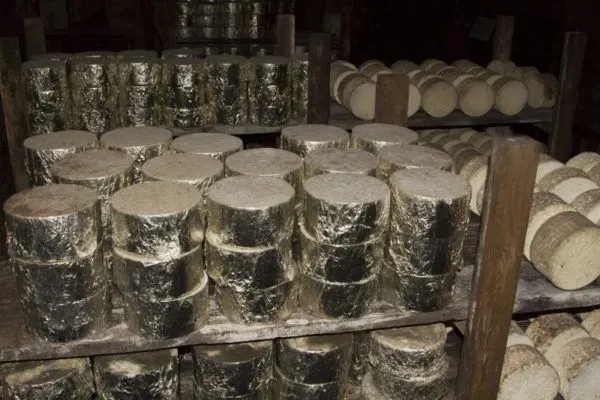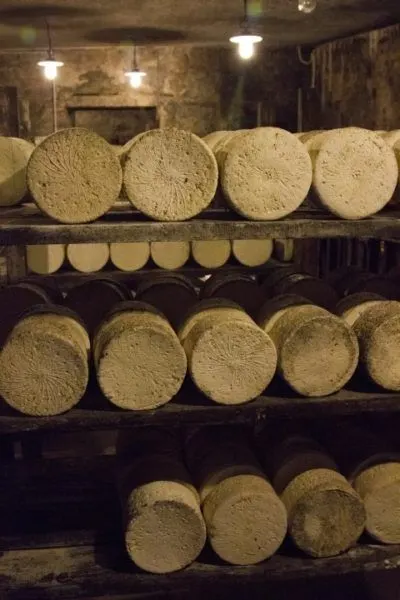Traveling through Southern France? If you are a foodie, head to Roquefort-sur-Soulzon and have some of the best cheese you’ve tasted in your entire life!
When in France…
Waitress: Ma’am, what kind of dressing would you like?
Me: Roquefort!
Waitress: Sorry ma’am, we only have blue cheese. Will that be ok?
Huh? I thought Roquefort and blue cheese were the same thing? Well, let me tell you, it is not! Just like the French have coined and now own the term “champagne,” and all the rest of the world must call theirs “sparkling wine”, they have done the same thing with Roquefort cheese, because the French are true foodies and want to have the most original of foods. And truly, I do not blame them.
Roquefort is produced in the town of Roquefort-sur-Soulzon in the south of France. Only the cheese made in this region can bear the name “Roquefort.” All others must only be called “blue.”
There are extremely strict rules for making this variation of cheese, and taking a tour run by Papillon, one of the manufacturers, was a true lesson.
To begin with,the milk can only be gathered from special ewes (from the Lacaune, Manech, and Basco-Béarnaise breeds) and only in one distinct area that encompasses about 23 square kilometers. According to the 1961 decree, only this small production area can claim the right to be called Roquefort cheese.
Why here? Well, legend has it that a young shepherd was eating his lunch and saw his beloved stroll past. With his lunch forgotten, he chased after her for a quick kiss and didn’t rediscover his meal until about two months later when the cheese had turned to Roquefort with its tell-tale blue streaks.
So what causes those blue streaks? Mold. Pure and simple. Mold. The caves produce this mold by commissioning a huge buy of bread loaves. The loaves are round and about 15 inches in diameter. They give the baker specific instructions to bake the bread at a very high temperature.

This bakes the crust and leaves the inside of the bread quite doughy. The loaves are stacked in the cellars and left for forty days where they grow a pretty blue-green, almost turquoise-colored mold, which is then injected into the cheese and left to age. Yum, yum!
This mold is said to have healing properties and can cure any number of diseases. And it is true that much later, in the early 1900s, Alexander Fleming called it mold penicillin and even won a Nobel Prize for his discovery. So there must be something to the health attributes of Roquefort, right?
At any rate, it tastes delicious! What can you do with this cheese, you ask?
I like to eat it in a number of ways. One of my favorites is on a salad with some good cured ham, nuts, orange or pear slices, and some raspberry balsamic vinaigrette.

Another way is to make it into a cream sauce and pour it over a steak. I first had this in Brussels, Belgium and it is to die for!
How do you like your Roquefort cheese?


Lo Dees
Tuesday 23rd of January 2018
Roquefort is one of my favorite cheeses. I find that it's not popular in my area and have had trouble locating it in local stores. I recently got some from GourmetFood.com. It was absolutely delicious.
Betty Carlson
Sunday 15th of March 2015
I have lived in the Aveyron department, although quite far from Roquefort, for 20 years and I sometimes forget how people DON'T know the difference between Roquefort and "bleu" -- although of course I had no idea of it before living in France.
My husband works with farmers and we are often lucky enough to get gifts of Roquefort from them. Sometimes I run out of ideas to what to do with it, although apparently it can be frozen fine and then used for cooking purposes. (We don't often do this, though.)
I think my favorite use is to make roquefort sauce for pasta, although that is actually not that traditional in the area.
It's rather surprising that a lot of people from the area actually don't like Roquefort at all! For a dinner party, I would likely never make a main course with Roquefort unless I was sure of my guest's tastes.
Corinne Vail
Sunday 15th of March 2015
Betty, It is a strong taste. I love to eat it on salads!
Phoebe @ Lou Messugo
Friday 6th of March 2015
Funny you should link this up today as I live in a "Roquefort" only my Roquefort is Roquefort les Pins not sur Soulzon and I can't tell you the number of times people assume I live in the cheese town. I've blogged about it here. http://www.loumessugo.com/en/blog/entry/roquefort-cheese-pines-goats-and-sheep I like Roquefort cheese in cooking, as a sauce, and I don't mind it in a salad but I'm not a massive blue fan so would never choose to eat it alone on bread. I love all other cheeses though! Thanks for linking to #AllAboutFrance Corinne.
Corinne Vail
Friday 6th of March 2015
Phoebe, It is fun. I hope I can keep contributing. For as many times as I travel to France I have not that much published. Gotta fix that!
Sally Higgins
Friday 6th of March 2015
I havn't tried the real roquefort yet but the motto for cheese in our house is 'maximum bacteria'. So I think I should! Thanks for the information and the pics :)
Corinne Vail
Friday 6th of March 2015
Sally, It was a great tour to find out about the "real" thing, and boy was it delicious!